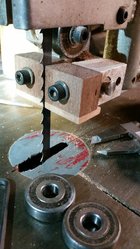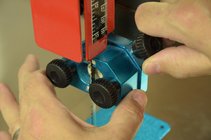I've got a Powermatic 1500 bandsaw that I mostly love. The main thing I don't love is the adjustment mechanism for the roller-bearing guide assemblies. The adjustment screws vibrate loose _all the time._ It's better now that I've applied some strategic dabs of Loctite to those threads, but now adjusting often involves using pliers to loosen the screws, which is an additional hassle. One solution to that would be to replace the knurled knobs with wing-screws which are easier to budge when they're tight, but it wouldn't solve the problem of the bearings getting badly gunked up when I cut green wood for bowl blanks (the primary use for my bandsaw).
I'm considering upgrading to an after-market guide assembly and would love to hear from those of you who've switched from bearings to blocks, or vice-versa. My old Delta bandsaw had block-style guides and they worked quite well. Carter is the after-market guide assembly company that I'm familiar with. Are there other brands I should be considering as well?
Kalia
I'm considering upgrading to an after-market guide assembly and would love to hear from those of you who've switched from bearings to blocks, or vice-versa. My old Delta bandsaw had block-style guides and they worked quite well. Carter is the after-market guide assembly company that I'm familiar with. Are there other brands I should be considering as well?
Kalia


